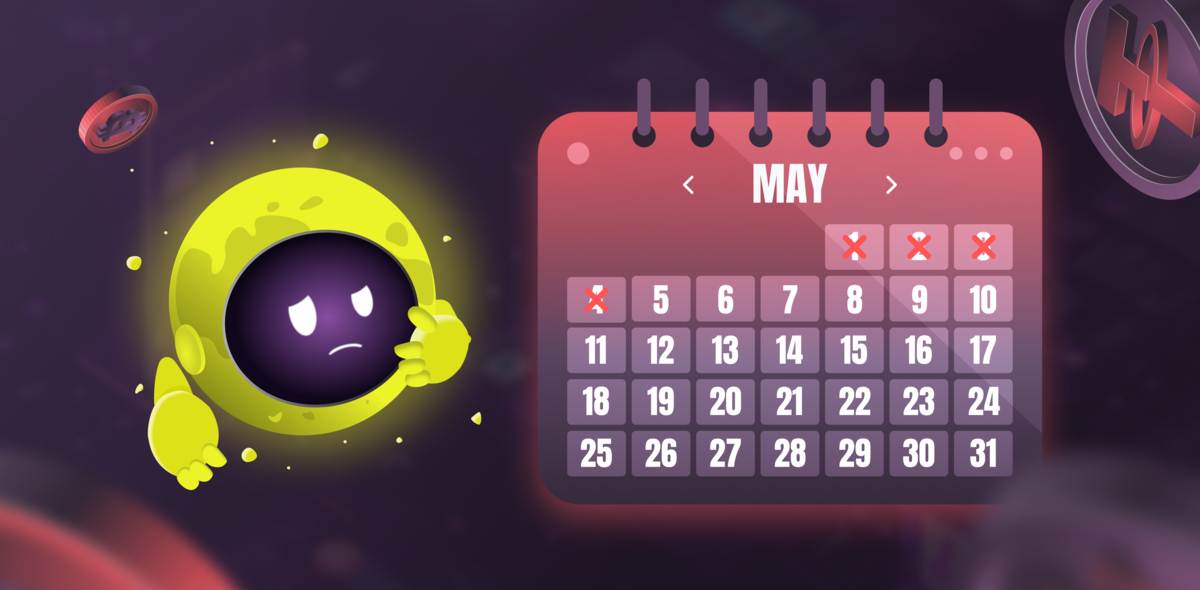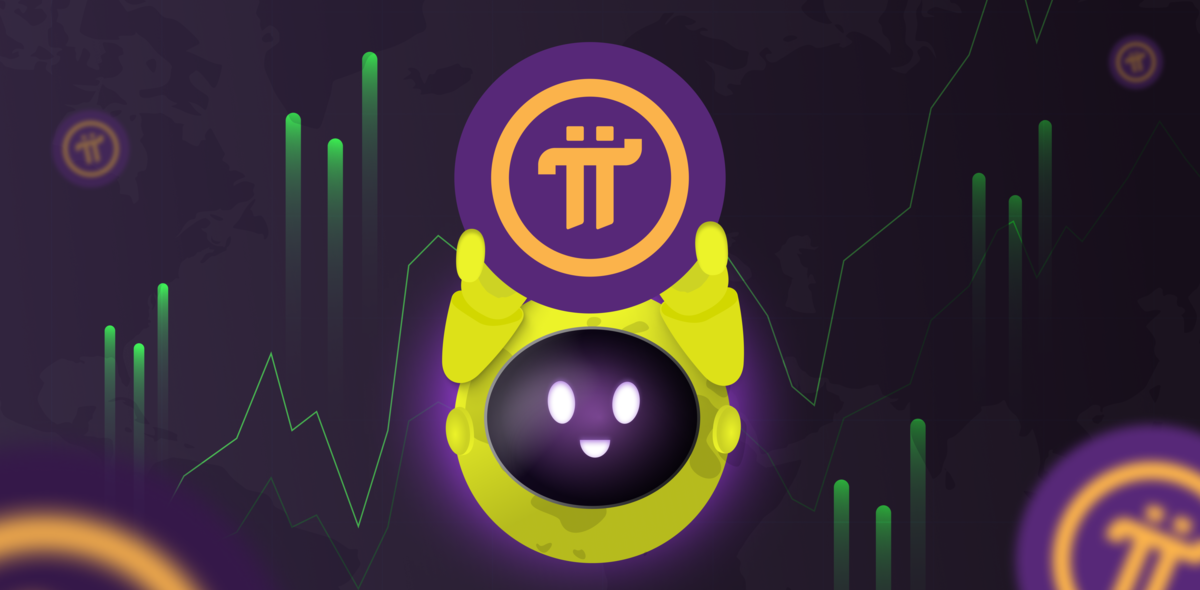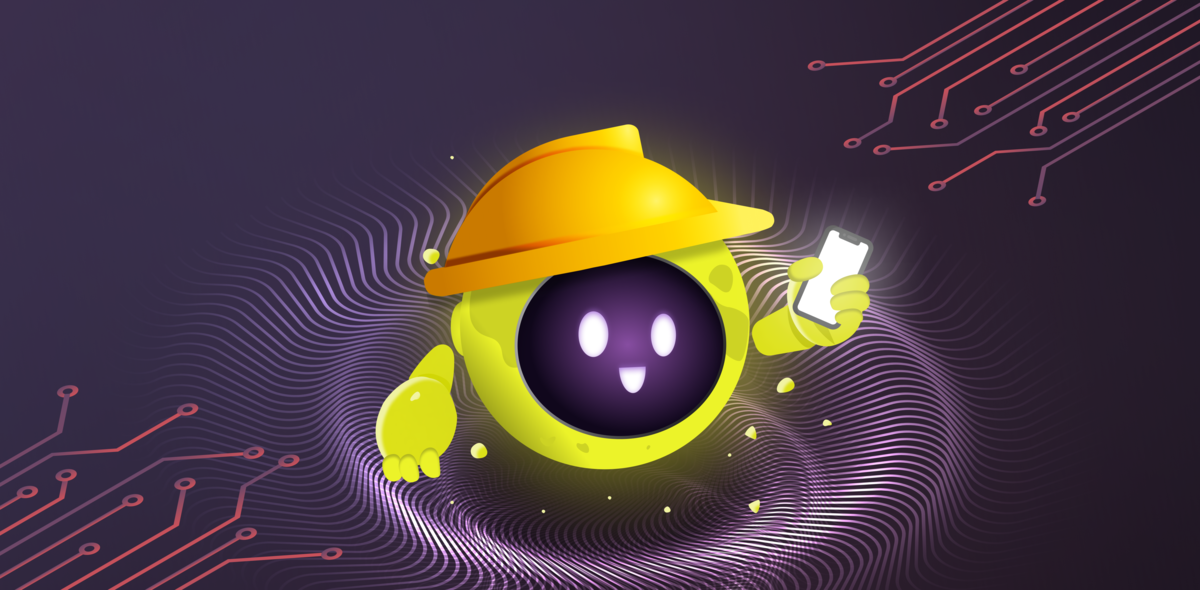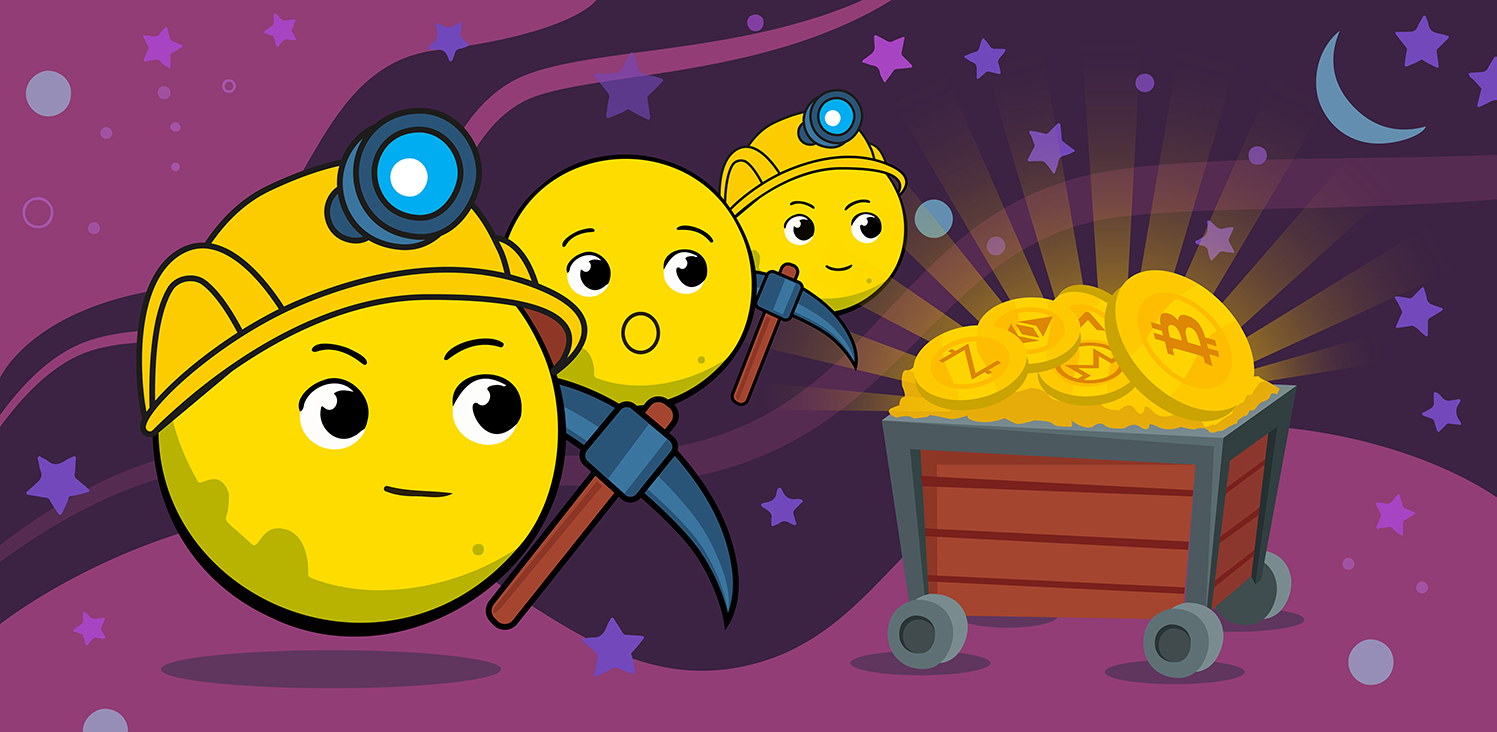
What Is Cryptocurrency Mining?
Cryptocurrency mining is one of the ways in which crypto’s circulating supply gets expanded. Although there are other ways like ICOs, mining is the oldest of them. It was introduced together with the first crypto — Bitcoin, and is a part of Bitcoin’s reputation of being “digital gold”: it’s bound to remind the public of scarce and precious metals.
As in the Gold Rush, the prospector looking to get rich from mining needs to get some equipment and join the ranks of thousands – or millions – of dreamers like him, to compete with them for rewards, which is as much a game of skill as it is the one of luck and chance. So, what is it exactly?
Cryptocurrency mining usually requires solving complex computational puzzles. This process has a double purpose:
- the puzzles are there not just to confound miners: they are needed to verify blocks (consisting of multiple transactions) so that they can be added to the blockchain;
- miners who keep the network secure by solving the puzzles get rewarded for their work.
In fact, the oldest software protocol used in the blockchain networks is called Proof-of-Work, because to get the reward, the work done by the first miner to solve the puzzle has to be accepted by all the other nodes in the network.
The puzzles involve the cryptographic challenge — hence the name, cryptocurrency — with a brute force mechanism which is usually called hashing. The chance to be that first person who can claim the reward gets lower when many people with the ability to solve the puzzles join the network — the speed with which different solutions can be computed across the network is called its hashrate. So, the prospective miner has to be just a little bit luckier than others — as well as have the fast-enough hardware. The types of hardware used for this are called CPUs (Central Processing Units), GPUs (Graphics Processing Unit), and ASICs (Application-Specific Integrated Circuits).
Things to Consider When Choosing a Cryptocurrency to Mine in 2023
As you may already know, or maybe have noticed just now, the process described above just says “cryptocurrency mining” without specifying which one. This is because there is a wide selection of cryptocurrencies to mine today. Here are some things to look at when choosing the best currency to mine for you personally.
Cryptocurrency Features
The most important factors are, of course, the ones inherent to the chosen currency itself:
- Different coins are designed to contain different numbers of transactions in one block, meaning that the frequencies with which block rewards are minted can differ across networks too;
- Block rewards differ not only in frequency but in size. Make note of the block reward for a coin, as well as whether there are halvings and if so, when;
- Different blockchain networks may use different variations of the hashing algorithm or employ different levels of puzzle difficulty. This can translate into differences in energy consumption volume across coins;
- The currency’s popularity is also a factor since it affects the network size: the more competition there is, the more taxing mining would be. This can affect — again — electricity consumption, accelerate wear and tear on equipment, as well as require upgrading and expanding mining rig regularly just to keep up;
- Another obvious factor affecting mining profitability in 2023 is the coin’s price: easily mineable but cheap coin may not bring as much profit as you’d like. Cryptocurrency price predictions are also important to consider: a coin with great prospects is probably a good choice for mining.
Your Location
The next group of factors that can influence the choice of a cryptocurrency to mine concerns where in the world you are, or rather where your mining rig is.
- Since electricity is one of the main resources used to mine crypto, you need to consider not only its consumption volume, which we already looked at, but also its price. Electricity costs are very regionally dependent so do your research. For example, generally, if you live somewhere with prices above $0.14/KWh, it’s not worth it;
- The regional regulations may also affect the choice of the cryptocurrency to mine: if a country hasn’t banned all crypto outright, it may still heavily regulate some particular currency mining or its subsequent trading;
- Hardware costs and accessibility may differ from location to location, so you may be limited in your choice in this way too.
Mining Hardware
This is probably the most obvious factor of all when thinking what is profitable to mine among mineable cryptocurrencies.
- The initial costs of the mining setup, including taxes, shipping, and installation;
- Or, for solutions like cloud mining, renting costs.
Is Cryptocurrency Mining Profitable in 2023?
Despite all the associated costs described above and other possible difficulties, overall, cryptocurrency mining is still profitable — otherwise, nobody would do it. For example, with the coins whose price predictions are good, one of the profitable strategies is mining and holding until they grow in price. Consider that the growth in electricity prices is often limited to 1–2% a year — far from the typical crypto price growth rate in a bullish year.
A good rule of thumb is to note the coin halving date if there is one: despite the diminishing reward, as this process cuts the inflation rate and increases scarcity, the price often surges after a delay. For example, Bitcoin price grew more than 6x within the year after the last halving, which took place in the spring of 2020.
Since one of the biggest costs to consider while calculating crypto mining profitability is the hardware cost, let’s take a closer look at the different mining setups.
Types of Mining: What Hardware to Use?
CPU
CPU mining is the oldest method, requiring the least specialized hardware: there is a CPU literally in any computer. So, if the network has a small hashrate, meaning a small competition pool, it’s possible to mine a cryptocurrency on a home PC. So, on one hand, this way demands the least investment, but on the other hand, as soon as the value of the crypto starts to grow, CPU mining very quickly becomes obsolete: there’s basically no chance to compete with another miner with the average CPU speeds.
GPU
GPU mining is the “next generation” after CPU mining. Due to their primary function — graphic processing — GPUs are good at performing some specific calculations, and they turned out to include calculations used in mining, thus giving miners using them an edge.
Some cryptocurrencies can still be mined effectively using GPUs, although current GPU mining setups are a far cry from the ordinary (albeit powerful) video cards which could be enough in the early days. Now, those miners who don’t use ASICs usually have many GPUs bundled together for that purpose.
One unintended negative consequence of GPU mining is that it has been seriously driving up GPU prices, which affects everybody who needs a computer with decent graphic performance: artists, designers, video content producers, gamers, and many more.
ASIC
The newest generation of mining software is called ASICs. Those are computer chips used for one purpose only — cryptocurrency mining. Most of the cryptocurrency mining now is done with ASICs, since they are the only things still allowing users operating them to be competitive in most cases. ASICs, however, are quite expensive and require some special skills in setting up.
Ways to Mine Crypto in 2023: Best Practices
Besides differences in the ways to mine crypto based on the hardware used, there are also different approaches to crypto mining based on the method. There are three main ways: solo, pool, and cloud mining.
Solo Mining
Solo mining is the first and most obvious approach. To do it, a miner has to buy the equipment, set up specialized mining software, and start mining. The main advantage of this approach is that the miner is completely independent — there’s no need to share the hardware or split the mining rewards with anybody. Also, this way can be satisfying on the “ideological” level: solo mining equals decentralization, just the way crypto was intended to be.
Most of the disadvantages of solo mining stem from the fact that by 2023 crypto mining has gotten seriously competitive, which means that to mine most cryptocurrencies profitably, one needs a serious setup, which can run up to $10,000 — otherwise, the chances of getting any kind of rewards are very slim.
Pool Mining
Pool mining entails buying the mining equipment and, as the name suggests, joining a pool — a setup made out of many such contributions, essentially functioning as a single mining entity. A pool has more computing power than any one person can usually afford, which means more chances to win a mining reward, even if the individual setup is not so expensive. So, this is the main advantage of pool mining compared to doing it solo.
On the other hand, mining rewards are split between all the miners in the pool, which may not feel good to the miners who feel that they could scrounge enough power to be competitive on their own. Secondly, mining pools are usually managed by so-called mining pool operators, who take their cut of the profits.
Besides the obvious losses, this may also be uncomfortable for many people since it means essentially letting the third party into the mining process — the very thing that crypto set out to destroy. Lastly, although the equipment needed to join a pool may not be very expensive, the miner still has to buy it.
Cloud Mining
Cloud mining can be seen as an evolution of pool mining. The difference is that instead of buying equipment to join, a miner can lease or rent a part of the existing mining farm, or cloud. The miners get part of the reward proportional to their contribution.
The advantages and disadvantages of this method are pretty much the same as with pool mining, although cloud mining doesn’t require an initial investment and therefore may be more attractive to the miners who are just starting out.
What Are the Best Cryptocurrencies to Mine? 10 Most Profitable Coins for Mining
Zcash

Zcash is a fork of Bitcoin with improved anonymity — there are no addresses or other identifying info in the transaction record. Zcash is hard to mine solo in 2023, as the network’s hash rate is very high now, so the best bet would be to join a mining pool. Consider in your calculations that, as usual, pool mining requires an initial investment — for example, ASICs cost $900+.
- Block reward: 3.125 ZEC
- Block time: ~75 seconds
- ZEC price: ~$153
- Next ZEC halving date: 2024
Ravencoin
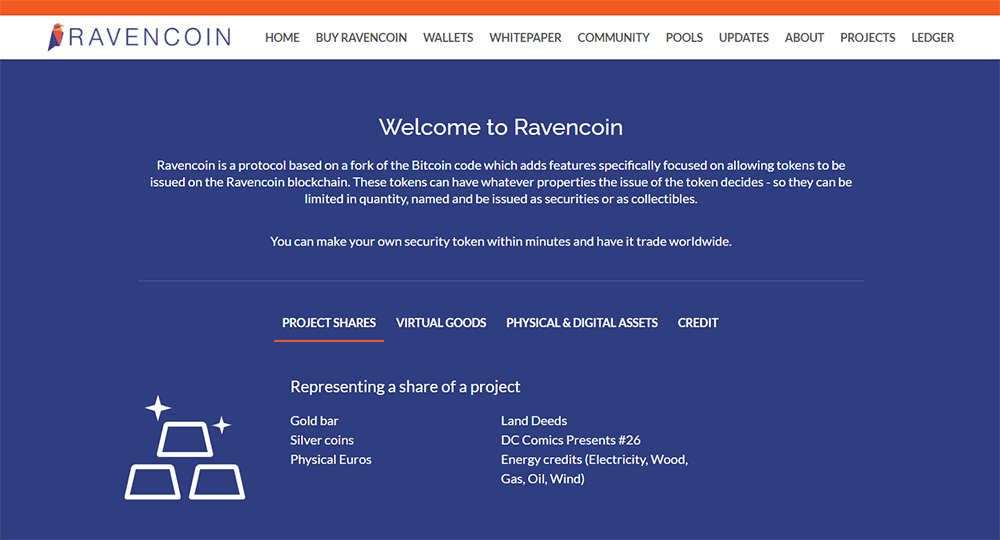
Ravencoin network is designed to facilitate light and easy instant payments. It has been forked off of Bitcoin and launched in 2018. Ravencoin is one of the most beginner-friendly coins to mine: it’s enough to use consumer-grade equipment to get results. The project’s team is actively working against the possibility to mine their coin with ASICs, changing the algorithm several times to cut those miners off. The current algorithm is called KAWPOW, and it works best with GPU pool mining.
- Best hardware to use: GPU
- Block reward: 5,000 RVN
- Block time: ~1 minute
- RVN price: ~$0.15
- Next RVN halving date: early 2026
- Best for: new miners
Ethereum Classic

Ethereum Classic is a result of a fork in the Ethereum blockchain, intended to keep the original chain alive. The advantage of this coin for a new miner is that it can be mined using GPU, i.e. not just high-powered ASICs. Note that Ethereum itself has recently changed its protocol to Proof-of-Stake. This may mean an interesting future for Ethereum Classic since the current Ethereum miners could decide not to waste their mining setups and switch to ETC. If this is the case, it may become harder for the new miner to get into Ethereum Classic mining in the future.
Note that instead of halving, ETC goes through a reduction: block rewards are not cut in half but instead get 20% lower every 4 years.
- Best hardware to use: ASIC
- Block reward: 3.2 ETC
- Block time: 13 seconds
- ETC price: ~$70
- Next ETC reduction date: early 2024
- Best for: the miners who cut their teeth on Ethereum
Dash

Dash is a currency with a focus on instant payments. It’s also one of the best cryptocurrencies to mine in 2023 considering its investment/rewards ratio. It uses X11 hashing protocol, which is, like Ravencoin’s protocol, a development aimed to deter ASIC miners and keep mining decentralized as long as possible. Dash mining is mostly done with GPUs and as such, this currency is considered to have a low barrier for entry.
- Best hardware to use: GPU
- Block reward: ~2.7 DASH
- Block time: 2.5 minutes
- DASH price: ~$241
- Next DASH reduction date: mid-2024
- Best for: new miners
Monero
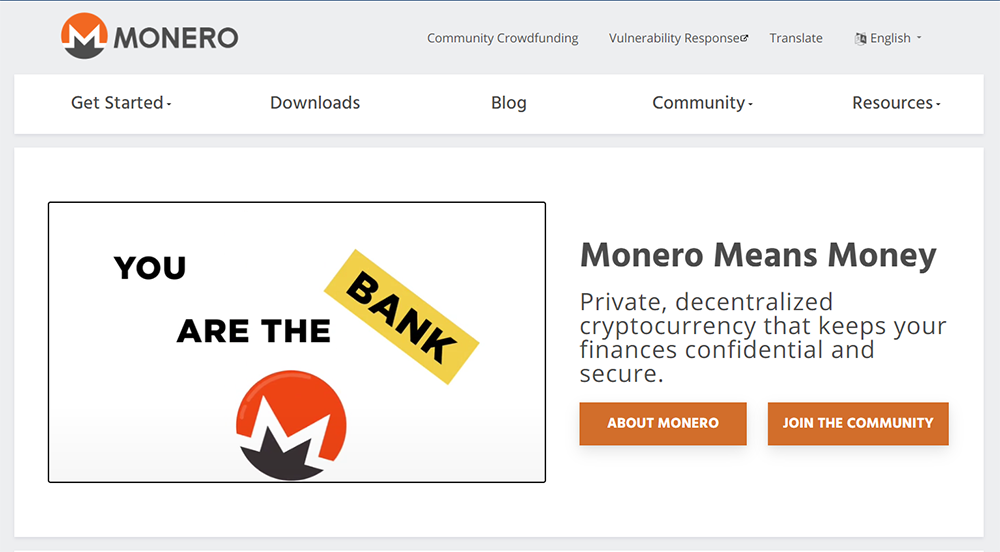
Monero is another privacy coin that’s great to mine in 2023. Monero is one of the better-known privacy coins. It doesn’t require an ASIC to mine and instead can be mined using CPU or GPU. Monero doesn’t have halvings, but the block reward was gradually reduced to 0.6 XMR, reaching this number in May 2022. After that, it’s staying at this level.
- Best hardware to use: GPU
- Block reward: ~0.88 XMR
- Block time: ~2 minutes
- XMR price: ~$305
- Best for: new miners
Dogecoin

Despite being a meme coin, Dogecoin is still one of the most lucrative cryptocurrencies to mine. Dogecoin gets a lot of attention, so its price can surge very quickly sometimes, although it’s not always predictable. This helps DOGE miners turn a hefty profit from time to time. On the other hand, Dogecoin uses the Scrypt mining algorithm, which means that it’s best to use ASICs to mine it, preferably in pools. Note that Dogecoin hasn’t had a halving since 2015.
- Best hardware to use: ASIC
- Block reward: ~ 10,000 DOGE
- Block time: ~1 minute
- DOGE price: ~$0.3
- Best for: miners with low risk aversion levels
Verge
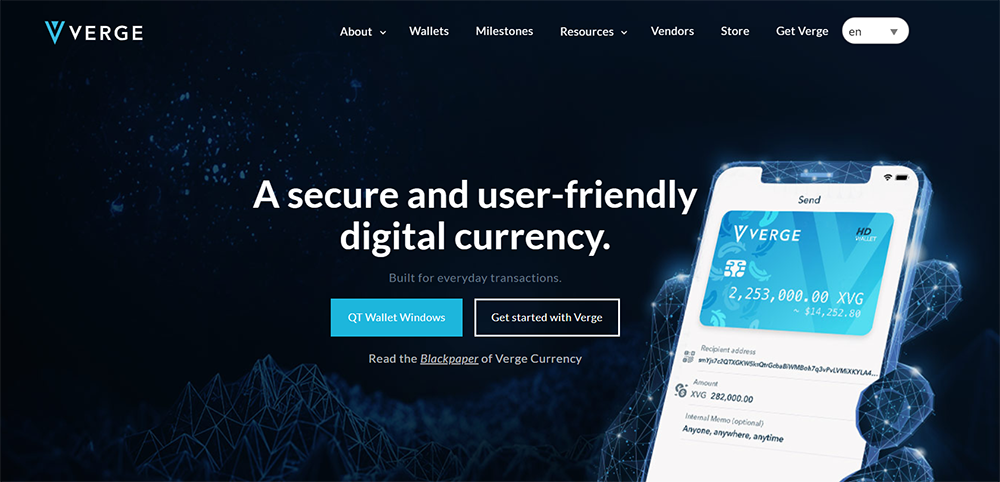
Verge is a cryptocurrency designed to combine good user experience with security in day-to-day transactions. Verge supports five hashing algorithms: Namely, Scrypt, X17, Lyra2rev2, myr-groestl, and blake2s. This means that this coin can be mined using many different setups, including GPU/CPU mining accessible for beginners.
- Best hardware to use: ASIC
- Block reward: 50 XVG
- Block time: ~34 seconds
- XVG price: ~$0.03
- Next XVG halving date: October 2023
- Best for: miners who are not afraid to dive into technical details
Peercoin

Peercoin is a sustainability-focused cryptocurrency. It was the first cryptocurrency using a hybrid Proof-of-Work and Proof-of-Stake consensus to reduce energy consumption. Peercoin uses the SHA-256 hashing algorithm, same as Bitcoin, and can be mined using any hardware that can be used to mine BTC. Nowadays Peercoin is not so popular anymore, but it works well as a starting point, for example, for a miner wanting to get into BTC.
- Best hardware to use: ASIC
- Block reward: 55 PPC
- Block time: 10 minutes
- PPC price: ~$0.92
- Best for: new miners with a great setup but needing “training wheels”
Vertcoin

Vertcoin was modeled on Litecoin as another ASIC-resistant cryptocurrency. It uses the Lyra2REv3 hashing algorithm. As opposed to Litecoin, which eventually switched to primarily ASIC mining, Vertcoin still can be mined using GPU, with pool mining being a recommended way.
- Best hardware to use: GPU
- Block reward: 25 VTC
- Block time: 2.5 minutes
- VTC price: ~$0.6
- Next VTC halving date: late 2025
- Best for: new miners
Decred

Decred is another one of the mineable coins founded in 2016 that started making waves recently. It’s heavily community-oriented. As it’s relatively obscure, it's still one of the most profitable crypto coins and can be considered one of the new coins to mine. This currency is using Blake256R14 algorithm and requires an ASIC miner.
- Best hardware to use: ASIC
- Block reward: ~7.27 DCR
- Block time: 3 minutes 41 second
- DCR price: ~$178
- Best for: new miners not minding unknown coins
Mining Profitability Calculators
To make things easier for a new miner trying to decide which cryptocurrency to mine in 2023, there are numerous profitability calculators online where one can plug in the necessary parameters such as electricity costs, hardware type and model, hashing algorithm, and others, and see how profitable crypto mining will be for him or her.
Mining Bitcoin in 2023: Is It a Good Idea?
Bitcoin mining in 2023 is a far cry from the times when you could just do it on your home PC bought for pennies and get 50 BTC block rewards. In other words, it's not the best coin to mine in 2023. However, you still can mine BTC and even get a good profit – it depends on your investment abilities, i.e. whether you can buy good hardware. If you can’t afford a high-quality mining rig, you can also join a pool or a cloud.
There are also some external circumstances to watch for. For example, there was an unexpected advantage for western miners that happened in 2021: China clamped down on mining. As a result, the number of miners in the network has fallen to about half as much as it has been, which makes mining easier and more profitable. The difficulty of the puzzles has already been adjusted, but the results still ripple through the community. Still, it might be best to look into what altcoin to mine, as listed above.
Advantages and Disadvantages of Mining Cryptocurrency in 2023
Pros
If you can afford the investment in equipment and are not very risk-averse, cryptocurrency mining is a great passive income source;
One can choose the currency to mine, make necessary calculations, and do their own research to determine whether it’s worth it: for example, there are cryptocurrencies with the hard cap, i.e. only the predetermined amount will be mined, and you can use it in your calculations.
Cons
Crypto mining used to be a very lucrative venture, but now there’s a lot of people doing it so a single miner gets fewer rewards;
Energy consumption: many people consider crypto mining a “dirty” process, so for environmentally-conscious people, it’s not a great look.
Crypto Mining VS DeFi: Passing Fad or a Revolution in Making Profits on Crypto? Is Mining Alive and Profitable after the DeFi Farming Boom?
DeFi is another way of making profits on crypto but it’s not clear whether the two should be compared. There is an interesting dynamic: to yield farm, one obviously should already have crypto, so yield farmer basically should watch both peaks and troughs in prices: buy low, stake high.
Another thing is that while farming one can’t use the bulk of his crypto, so (to avoid FOMO) the farmer should make up his mind to hold. On the other hand, miners are free to sell their crypto as soon as they get it, so there’s less pressure to plan long-term; obviously the higher the price, the better.
The best thing would probably be to hedge one with another: focus on mining new coins while the price is high and on buying them while the price is low, while continuously yield farming.
Final Words
Cryptocurrency mining can still be very profitable in 2023. However, there is a lot of factors to consider, including the features of the coin itself, where you are, and what hardware you can afford. The best bet for a new crypto miner in 2023 is probably using a mining pool or cloud, as the field has become quite competitive.
There is a lot of information to help a beginner in crypto mining to choose the right coin, hardware, and method to start, so as always you are welcome to do your own research. If chosen well, crypto mining can become a good source of passive income for a long time.
Frequently Asked Questions
Which cryptocurrency is the easiest to mine in 2023?
The easiest cryptocurrencies to mine in 2023 are probably the ones that are ASIC-resistant — Monero, Dash, Vertcoin. They don’t require specialized hardware, instead making use of GPU chips that are in many home computers. This makes it easier for a new miner to start making sense of the crypto mining process. Note that the easiest coin to mine doesn't equal the best coin to mine, or even the most profitable cryptocurrency to mine.
What is the best crypto to mine right now?
The best crypto to mine in 2023 — right now — is probably different for every miner, as you have to consider all the details like electricity costs, hardware affordability, etc. You are advised to do your own research to decide for yourself what is the top currency to mine.
What is the best cryptocurrency for cloud mining?
The best cryptocurrencies for cloud mining are those that require investment-heavy setups and are sufficiently stable so that the investor doesn’t lose money during his contract. For example, Bitcoin mining can be worth it, since mining it efficiently solo or even in a pool requires a lot of money in equipment costs. Try to play around with mining profitability calculators to find out more.
Is mining pool more profitable than solo mining?
Mining pools probably should be considered more profitable than solo mining in 2023, when the competition is that high. Mining pools offer less profits at a time than solo mining, but more opportunities to get profits — individual miners have less chance to add blocks nowadays, especially to large chains.

